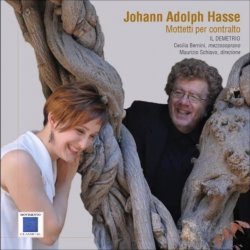
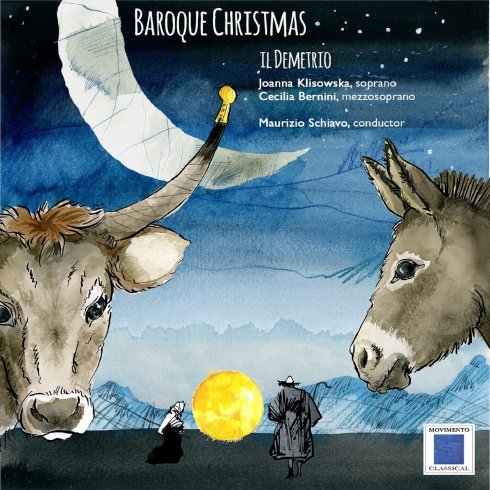
Baroque Christmas
From Christmas Carols to traditional German melodies reinterpreted by Bach, from Piva piva and Tu scendi dalle stelle to Jingle Bells: there is a long and curious story behind the Christmas music on this CD by Maurizio Schiavo and the Il Demetrio Baroque ensemble. Representing both liturgical and devotional music, folk music and art music, these songs have been collected to create an anthology that is wonder fully in tune with the festive atmosphere of Advent and the Christmas season:Their charm is enhanced by the haunting sound of the original instruments on which they are played. The ritual of telling the story of the birth of Jesus through music and song is so ancient that it's origins have been lost in time. The feast of Christmas was instituted by the Roman church toward the middle of the 4th Century of the Christian era, overlapping with the pre-existing rites linked to the winter solstice (December 25th was the feast of Sol Invictus in the pagan Roman world). As early as the beginning of the following century, it seems that the feast of Christmas had been accepted by all the most important Christian communities, and definitively seton December 25th. It was in these years that the first liturgical songs linked with Christmas that we know of were composed (including the hymn Veni redemptor gentium, attributed to Saint Ambrose, and Corde natus ex Parentis, by the poet Prudentius). Over the following centuries, the missionaries sent to convert the Germanic peoples of the time linked the celebration of Christmas with the feast of Yule (which was also associated with the winter solstice), absorbing elements from their pagan traditions and symbolism, such as the fir tree, mistletoe and holly. In the Middle Ages there was a decisive turning point with the spread throughout Europe of religious pageants and Mystery Plays. Alongside the official repertory in Latin, which naturally continued to be sung during liturgical celebrations, a corpus of melodies that re-elaborated and commented upon the story of the Nativity narrated by the Gospels, using Vulgar Latin (or macaronic Latin). In Italy the mystical experiences of Saint Francis of Assisi and the subsequent spread of the lauda (without forgetting, as far as religious pageants are concerned, his famous Nativity Scene at Greccio, Christmas 1223): at the same time the Villancicos became popular in Spain, as did the Noëls in France, as did the first Carols in England, and the Koledy in the Slavic regions. These are simple songs, the expression of the people, and of their authentic religious sentiment, giving voice to feelings of joy, contemplation and devotion. The first anthologies of this new repertory were soon made: at first manuscript collections (in this form the most ancient songs, such as In dulci Jubilo, have come down to us); and then, from the 16th century onwards, large songbooks were published, which appeared in various countries and allowed these musical forms to circulate widely. The role of the Reformation was crucial, which introduced spoken languages into Christian rites in place of Latin, thus introducing also songs in German (and then in the other spoken national languages) to religious celebrations. Luther himself wrote a large number of these devotional songs. As far as the music was concerned, he often made use of pre-existing melodies to make it easier for the congregations to learn the new songs. In many cases, nevertheless, the music was also newly composed, such as in the case of the famous Von Himmel hoch (here, the melody may well have been composed by Luther himself).The creation of new Christmas songs, a process that has continued to the present day with crossovers between religious and pop music, is a complex phenomenon. Pre-existing texts may be set to newly composed melodies (as is the case of Hark! The Herald Angels Sing, adapted from a composition by Mendelssohn). The reverse process is more frequent, with recent texts being created for older melodies. To give just a few examples, we can look at Angels We Have Heard on High, O Tannenbaum (which is based on an ancient folk melody), Ding Dong Merrily On High (which makes use of a French Renaissancedance), and What Child is this? (a 19th century text set to Greensleeves, the well-known traditional English melody). Naturally, in every era wholly new songs have also been written, which have rapidly earned their place in the Christmas repertory (from Stille Nacht and Jingle Bells to the more recent White Christmas and Happy X-mas). At the beginning of the 19th century, the publication of the anthologies Some Ancient Christmas Carols (1823), and Christmas Carols Ancient and Modern (1833) led to renewed interest in traditional Christmas melodies that culminated in the Victorian era. It was at this time that the idea it self of Christmas changed, and took on the form of a festivity focused on the family in which old and new elements existed side by side (such as the tree, household decorations, the family dinner, the exchanging of gifts, toys for children, Christmas cards, etc.). This new way of conceiving of and celebrating Christmas (which is substantially the same in our day), rapidly spread throughout the world, and Carols were its quintessential musical accompaniment. There are many and varied types of Christmas songs: a large part of the repertory tells the Gospel tales of the Nativity and connected events, from the Annunciation to the visit of the Three Kings (God Rest Ye, Merry Gentlemen; Angels We Have Heard on High; Joseph est bien marié). In this category we also find songs that fall into specific genres, such as lullabies (that the Virgin Mary sings to Baby Jesus) or pastorals, which were highly successful in the field of instrumental music in the 17th and 18th centuries, too. Another important group includes songs with lyrics that call for prayer, celebrations and joy for the birth of the Saviour (Ding Dong Merrily On High). There are also some songs which originally were not Christmas songs: such as Jingle Bells, a simple illustration of a merry winter scene. The Italian tradition is represented here by two well known pieces, Piva piva and Tu scendi dalle stelle. The former, an ancient melody – perhaps a lullaby – revisited, has many variations both in melody and lyrics (its melodic profile can still be made out in the third act of Le Nozze di Figaro, by Mozart in 'Ricevete o padroncina') and is considered a 'good luck song' if it is sung on Christmas Eve before entering church. The oldest version of the lyrics says Play, pipes, play, there's olive oil. It seems to have been composed as a form of advertising for oil merchants from Brescia, who were determined to use both the festive spirit of the Christmas season and the charm of the baghet, the typical bagpipes of Bergamo, to sell the fruit of the olive harvest, which was ready in December. Whether this story is true or not, the fact remains that Piva piva has lost it's original meaning and has become one of the most famous Italian Christmas songs. Tu scendi dalle stelle is, on the other hand, an extremely successful example of a spiritual song linked to the liturgical calendar, which the bishop and composer Alfonso Maria de' Liguori wrote around the middle of the 18th century. Thanks to his pastoral work among the poor folk of the Kingdom of Naples the missionary taught them the fundamentals of Christianity using folk songs as a special form of catechism. In the 16th century Sa int Filippo Neri had renewed the practice of the spiritual lauda, giving life to a rich repertory that endures in many prayers sung in manycommunities. Saint Alfonso continued the emancipation of the grand tradition of the sung catechism by composing many spiritual songs linked to the liturgical calendar. In these songs he was able to perfectly translate the feeling of wonder and joy present in the Gospels. Some of these songs became very famous indeed, beginning with Tu scendi dallestelle which, composed around 1754, immediately enjoyed extraordinar y success, to the point of being, a few years later, published throughout Italy. Thefirst example of a truly Italian song.

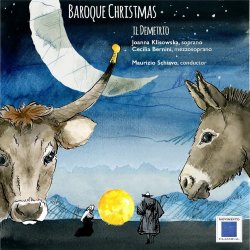
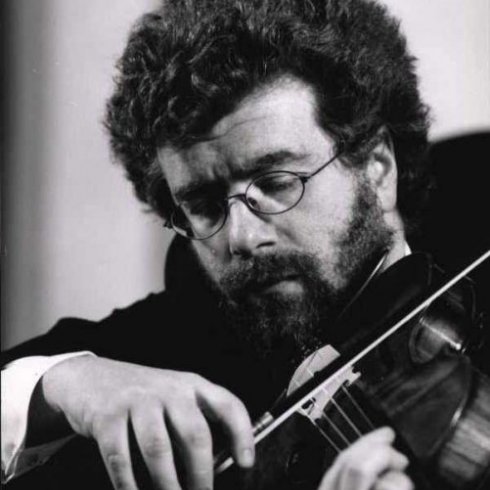
MAURIZIO SCHIAVO
A great musician and a great talent, Maurizio Schiavo has studied baroque violin with Enrico Gatti and has followed master classes with Piero Toso and Sigiswald Kujiken. He also attended composition courses and was a student of Eliodoro Sollima and Niccolò Castiglioni: his works have been performed in important Italian contemporary music festivals. In 2008 he founded “Il Demetrio” ,one of the most lively groups with original instruments of the Italian scene , mainly devoting himself to the performance of the classical and baroque repertoire, combining the interpretative commitment with the musicological research on the Italian repertoire of the 600’-700’. He graduated in orchestral conducting with Giampiero Taverna and in orchestral conducting for the opera with Umberto Cattini. He has conducted in the first modern performance, also taking care of the revision, unpublished compositions by Antonio Cagnoni and Franco Vittadini; he has recorded the Quartets for flute and strings and he has conducted in the first modern performance the sacred compositions. As an instrumentalist he has reproduced the “Mottetti per voce e strumenti” by Bianca Maria Meda and numerous compositions by Alessandro Rolla.
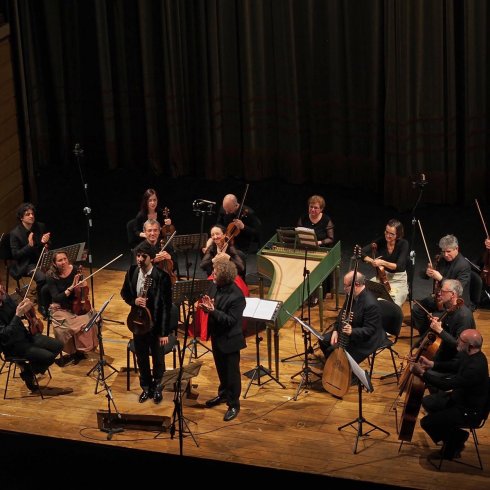
Ensamble “IL DEMETRIO”
The Demetrio is one of the most lively groups with original instruments of the Italian scene, it was founded in 2008 in Pavia by Maurizio Schiavo and takes its name from the musical history of the city: The Demetrio is in fact the title of the opera of the Bohemian Josef Myslivecek who in 1773 inaugurated the Teatro dei Quattro Cavalieri, today the Teatro Fraschini.
The “Demetrio” ensemble, since its early years of activity, has given life to a project of rediscovery and enhancement of the musical heritage of Pavia and its province by proposing numerous important compositions for the first modern performance. Among the compositions brought to light we remember the opera " il Demetrio" performed during the “Festival dei Saperi 2010”, the compositions for the cinema "Sound Landscapes” by Franco Vittadini , “Tantum ergo” for soloists, choir and orchestra and Dixit Dominus for bass, viola concertante and orchestradi Alessandro Rolla, three compositions for the Holy Week (Adoramus te, Miserere and Christus factus est) for choir and strings by Antonio Cagnoni.
